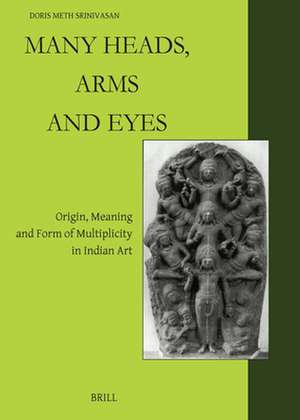Many Heads, Arms and Eyes: Origin, Meaning and Form of Multiplicity in Indian Art
Autor Doris Meth Srinivasanen Limba Engleză Paperback – 3 feb 2021
The first part establishes a general definition for the convention. Examination of all Brahmanical literature up to, and sometimes beyond, the 1st - 3rd century A.D., adds more information to this basic definition.
The second part applies this literary information mainly to icons of the Yaksa, Śiva, Vāsudeva-Kṛsṇa and the Goddess, and indicates how Brahmanical cultural norms, exemplified in Mathurā, can transmit textual symbols.
Both Part I and Part II provide iconic modules and a methodology to generate interpretations for icons with this remarkable feature through the Gupta age.
Preț: 459.76 lei
Preț vechi: 540.90 lei
-15% Nou
Puncte Express: 690
Preț estimativ în valută:
87.97€ • 95.86$ • 74.13£
87.97€ • 95.86$ • 74.13£
Carte indisponibilă temporar
Doresc să fiu notificat când acest titlu va fi disponibil:
Se trimite...
Preluare comenzi: 021 569.72.76
Specificații
ISBN-13: 9789004448308
ISBN-10: 9004448306
Dimensiuni: 210 x 290 mm
Greutate: 1.4 kg
Editura: Brill
Colecția Brill
ISBN-10: 9004448306
Dimensiuni: 210 x 290 mm
Greutate: 1.4 kg
Editura: Brill
Colecția Brill
Notă biografică
Doris Meth Srinivasan, Ph.D., University of Pennsylvania, is Research Professor at Mattoo Center for India Studies, State University of New York/ Stony Brook University. She has published extensively on the art of Mathura; Hindu iconography; Vedic studies, including Vedic and ancient Hindu rituals.
Her books include Listening to Icons; Indian Iconographic and Iconological Studies (2016), On the Cusp of an Era in the Pre-Kusāna World (2007) and Concept of Cow in the Rigveda (second printing 2017; originally 1979).
Her books include Listening to Icons; Indian Iconographic and Iconological Studies (2016), On the Cusp of an Era in the Pre-Kusāna World (2007) and Concept of Cow in the Rigveda (second printing 2017; originally 1979).
Recenzii
"Doris Srinivasan’s remarkable monograph on multiplicity in the Indic tradition draws also on multiple disciplines — Indology, archaeology, and art history among them — to address concepts of origin, creation, differentiation, and embodiment. Without these, India’s material remains cannot be understood. Reading her study is a responsibility and a pleasure, landmark and revelation. For Art History and other disciplines it provides an essential richness and frame for understanding." - Michael W. Meister, W. Norman Brown Professor emeritus, University of Pennsylvania
"Il est désormais impensable de parler d'hindouisme ancien sans consulter ce livre (...) un très beau livre de l'histoire de l'art et d'histoire des religions, magnifiquement pensé et magnifiquement écrit." - Gérard Fussman, in: BEFEO 85 (1998)
"The book must be read by everyone who works on the art and religion of early India. Coomaraswamy and Kramrisch (who was one of the Srinivasan's teachers) would be proud of her work." - Robert L. Brown, in: Journal of the American Oriental Society, 2001
"Il est désormais impensable de parler d'hindouisme ancien sans consulter ce livre (...) un très beau livre de l'histoire de l'art et d'histoire des religions, magnifiquement pensé et magnifiquement écrit." - Gérard Fussman, in: BEFEO 85 (1998)
"The book must be read by everyone who works on the art and religion of early India. Coomaraswamy and Kramrisch (who was one of the Srinivasan's teachers) would be proud of her work." - Robert L. Brown, in: Journal of the American Oriental Society, 2001
